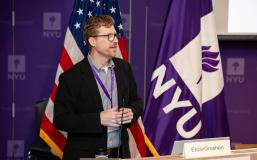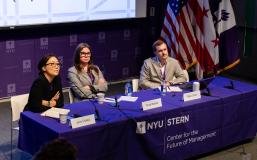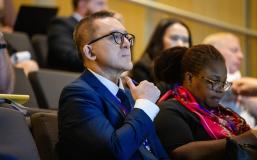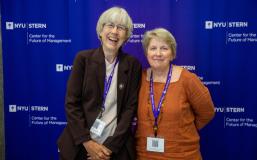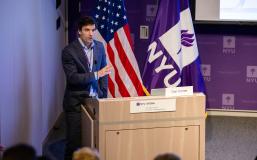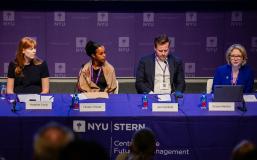
2024 Regional Disparities in AI Adoption Conference
2024 Regional Disparities in AI Adoption Conference
Date
Recap of the 2024 Regional Disparities of AI Adoption Conference
On July 12, 2024, NYU’s Center for the Future of Management hosted a conference focused on regional disparities in AI adoption at NYU’s Washington DC campus. The in-person conference was attended by approximately 90 participants from academia, industry, non-profit and government organizations. Support for the conference was generously provided by the Alfred P. Sloan Foundation. The in-person conference revolved around the six themes that emerged during a virtual meeting of a similar group of individuals on April 10, 2024. The six themes were: measurement, policies, relationship to other technologies, role of specialized human capital, spillovers, and effect on labor, each recapped below.
Measurement. How to measure AI? Are current measures picking up AI or something else? How to differentiate between “AI Producing” vs “AI Using”? What specific types of data would be useful in each case, knowing the need for local (county or commuting zone) information? Are we missing grassroots and/or open source activities?
Policies. What regional differences in policies might help explain the adoption patterns? What policies (existing or contemplated) should be considered to spur additional adoption (especially in geographies that are lagging), and do we even want to spur additional adoption? What policies should be considered to help the workforce adjust to disruption from AI? What role do unions play? Is there a role for credentialing/ micro-credentialing?
Relationship to other technologies. How much of what we see is specific to AI, as opposed to other pre-existing local factors, including prior technologies (such as the Internet)? What is the role of computing power, which might be based in specific locations? What is the role of chip manufacturers, which might be based in specific locations?
Role of specialized human capital in adoption and use. What human capital is needed in an area to spur adoption and use of AI? Who are the “AI Integrators” and where are they located? The location of universities seems to matter, but how much do universities matter for production of talent vs. use of talent?
Spillovers. What are the effects of regional agglomeration of AI on local areas that are (i) part of the agglomeration region or (ii) outside of the agglomeration region? What might explain or moderate spillovers between firms and/or regions (including internationally)?
Effect on labor. Which jobs will be displaced and where? How do workers respond to potential displacement and substitution? Do firms have different strategies (e.g., different cultures around work) and/or are there other social factors that might explain some of the ways in which AI is adopted and used? When, how, and where will AI involvement lead to the “augmentation” of tasks and occupations, and when will it lead to “automation?”
In opening remarks, Rob Seamans from NYU’s Stern School of Business described how the conference intended to examine these six themes via four sets of panels and a keynote address, as well as ample time for discussion and networking between participants. Mark Muro from the Brookings Institution then highlighted the long history of academic interest in geographical clustering of economic activity before highlighting recent research, which suggests that AI and other emerging technologies appear to exhibit similar patterns of clustering.
The first panel focused on definitions and measurement. It was chaired by Erica Groshen from Cornell University and featured presentations by Lee Branstetter from Carnegie Mellon University, Lucia Foster from the U.S. Census Bureau, Julia Lane from NYU and Lisa Simon from Revelio Labs. The panel presentations and discussion highlighted the multiple ways to collect data on AI adoption, including from patent data, resume profiles, U.S. government surveys and NSF or other grant data. Open questions include how much overlap exists between these various approaches and what factors might explain differences in findings across these approaches.
The second panel focused on the impacts of AI on firms, workers and regions. It was chaired by Jane Dokko from the Department of Commerce and featured presentations by Tania Babina from Columbia University and Peter Cihon from GitHub. Tania Babina highlighted recent research linking AI investment by firms to increases in sales, employment and market value. She also highlighted new research that these firms’ AI investments are associated with firms’ increased systematic risk. Peter Cihon described recent research from field experiments that show use of GitHub’s Copilot, an AI tool for software developers, is linked to increased developer productivity. Moreover, the less experienced developers appear to benefit the most. An issue highlighted by this panel is that most of the recent work on AI done by economists has focused on firm-level and worker-level outcomes, and there is comparatively little on regional outcomes.
A fireside chat following lunch featured a conversation between Simon Johnson from the Massachusetts Institute of Technology and moderator Mark Muro from the Brookings Institution. The discussion focused on the wide variety of factors that might explain the regional clustering of economic activity, and technology adoption in particular, and also a variety of economic policies that might help increase adoption in other areas. For his part, Johnson stressed the agency of humans (through their governments) to shape outcomes.
The third panel focused on the role of federal policy in AI adoption, with a specific emphasis on recent policies such as the CHIPS and Science Act which includes billions of dollars for research in AI and other emerging technology. The panel was chaired by Dan Correa from the Federation of American Scientists and featured a moderated discussion between Jon Cardinal from Senator Schumer’s office, Heather Long from the Washington Post, Gracie Narcho from the National Science Foundation and Hodan Omaar from the Information Technology and Innovation Foundation. The panel discussion highlighted the importance of investment in AI for economic growth as well as national security issues. The discussion also highlighted some of the challenges with directing funding to specific research areas or regions, especially if the requisite human capital is not yet in place.
The fourth panel focused on technology and workforce issues. It was chaired by Allison Forbes from the Center for Regional Economic Competitiveness and featured presentations by Christophe Combemarle from Carnegie Mellon University, Michael Handel from Northeastern University and Commissioner Keith Sonderling from the Equal Employment Opportunity Commission. The presentations in this panel highlighted that in order to understand the effect of AI on jobs and labor, it is important to understand how AI affects the various tasks within a job. The discussion also highlighted that while existing laws regulating the relationship between firms and workers are old, that does not mean they are necessarily outdated, though more research and work is needed in this area. An open question raised by this panel is that it is still not clear under what conditions AI will complement or substitute for human work.
After the event, conference participants responded to a survey about the six themes. They reported that the three themes receiving the most attention were (in order): effect on labor, measurement, and policies. They reported that these same three themes were the three that should have been highlighted. The themes with most interest going forward are effect on labor and policies; these two themes received an overwhelming majority of votes. Overall, the feedback on the conference was very positive, though it was noted that there was lots of focus on academic and policy points of view, and not as much from a business point of view.
Conference Photos
